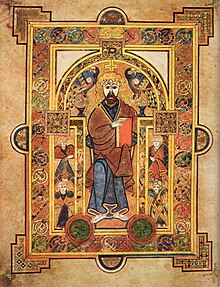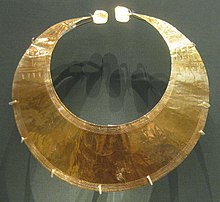
The history of Irish art starts around 3200 BC with Neolithic stone carvings at the Newgrange megalithic tomb, part of the Brú na Bóinne complex which still stands today, County Meath. In early-Bronze Age Ireland there is evidence of Beaker culture and a widespread metalworking. Trade-links with Britain and Northern Europe introduced La Tène culture and Celtic art to Ireland by about 300 BC, but while these styles later changed or disappeared under the Roman subjugation, Ireland was left alone to develop Celtic designs: notably Celtic crosses, spiral designs, and the intricate interlaced patterns of Celtic knotwork.

The Christianization of Ireland in the fifth century AD saw the establishment of monasteries, which acted as centres of scholarship, and led to the flowering of the Insular art style with its highly decorative illuminated manuscripts, metalwork and stonework (High crosses). From around 1200 to 1700, however, Irish art was relatively stagnant, and Irish culture was left comparatively untouched by the influence of Renaissance art.
From the late 17th century, talented artists began to emerge in the fields of fine art, particularly the painting of portraiture and landscapes. The early 18th century saw increased prosperity and establishment of new cultural institutions including the Royal Dublin Society (1731) and Royal Irish Academy (1785). In the Victorian era, with a lack of patronage and better opportunities to be found abroad, many Irish artists emigrated to London (portraitists) or Paris (landscapists), which stifled the nascent indigenous scene. By the dawn of the 20th century, things began to improve. Opportunities began to spring up at home; the Celtic Revival movement saw a renewed interest in aspects of Celtic culture, Hugh Lane established the Municipal Gallery of Modern Art, the first public gallery of its kind in the world, and with increased patronage a new generation of homegrown talent and returning emigres gradually formed a solid basis for the regrowth of art in Ireland. The foundation of an independent Irish State in the early 1920s did not significantly alter the state of Ireland's visual arts; in the years following Independence, the arts establishment (exemplified by the committee of the Royal Hibernian Academy) was dominated by traditionalists who steadfastly opposed attempts to bring Irish art into line with contemporary European styles. [citation needed]
© MMXXIII Rich X Search. We shall prevail. All rights reserved. Rich X Search
